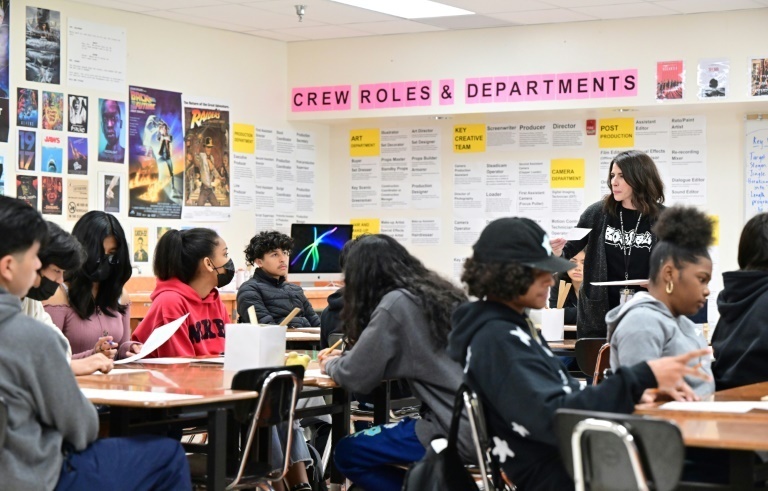At just 14 years old, Ja'saray Juarez debates what makes a good ad with her friends -- catchy music, clever camera work and appealing characters are all part of the mix. She will eventually film her own commercial to show her class.
In a few years, the freshman hopes to launch her career behind the camera, thanks to a special program at her Los Angeles high school for hundreds of young people from underrepresented communities looking to break into showbiz.
Since September, the public high school has been home to a magnet program for film and television studies that has received financial backing from Oscar winner George Clooney.
"I'm so glad I get to learn about how to make films... how to script, how to write dialogue," the teen told AFP in a classroom decorated with movie posters, old-school film clapboards and even a director's chair.
Ninety percent of the students at the Edward R. Roybal Learning Center are Latinos, and many of them come from families of modest means. For them, Hollywood Boulevard and the starry Walk of Fame are worlds apart from their own realities.
To help those students chase their entertainment business dreams, Clooney rallied some of his famous friends -- including actors Eva Longoria and Don Cheadle -- along with Paramount, Disney and other studios to fund the project.
The goal? To combat the lack of diversity in US film and television -- an issue that often rears its head at the Oscars, set for Sunday -- from the bottom up.
- 'Starting early' -

"That means starting early. It means creating high school programs that teach young people about cameras, and editing and visual effects and sound and all the career opportunities that this industry has to offer."
Costume designers, lighting technicians, hair and makeup artists -- in Ja'saray's classroom, posters listing 80 or so showbiz professions are there to show students the variety of paths available.
"I had absolutely no idea that there were that many. I thought it was just basic director and actors," says the teen, who explains she initially wanted to try her hand at animation but now is thinking about pursuing screenwriting.
"It just opened my eyes."

Since the eruption of the #OscarsSoWhite equality movement in 2015, on-screen representation of minority communities has been scrutinized.
The Academy of Motion Picture Arts and Sciences, which organizes and hands out the Oscars, admitted a large number of new members to diversify its voter rolls.
Slowly, that process seems to be having the desired effect.
This year, many observers see the 11 nominations for the frontrunning "Everything Everywhere All at Once," a zany sci-fi romp with a primarily Asian cast, as a sign of progress.
- Internships -

"There's a real diversity problem, especially on crews," says Brittany Hilgers, who teaches film basics at the school after 12 years as a working screenwriter.
The Annenberg School for Communication and Journalism at the University of Southern California is one of the few academic institutions to study diversity in Hollywood, under its "inclusion initiative."
From 2016 to 2018, researchers went through the credits of 300 films. They found that 80 percent of all film editors were white men. Only 14 percent of costume designers were minorities.
The Roybal program hopes to move the needle by leaning on unions and its studio partners to offer internships, possibly leading to job placement.
After a year of generalized film study at the school, they gradually specialize in a chosen field -- in addition to their regular studies in standard subjects like math and science.
"The kids that want to do editing are going to learn how to do editing on the actual software that the people in the industry use," Hilgers explains, emphasizing that teachers are looking to help the students graduate with marketable skills.
For a sector in need of fresh faces, "it is important to invest now and not wait until they get to college, because the truth is, not every student makes it there," says the school's principal Blanca Cruz.

He's already learned to use film editing software and a boom mic.
Beyond the practical skills, Flores says he's getting lessons in how to network.
"Now that I'm here in the school, I see a pathway for myself" in the industry, he says.
Cruz says she is hoping to eventually see the film program instituted in other LA public schools. Clooney has said he envisions taking the idea to New York, Chicago and Atlanta.
rfo/sst/des
© Agence France-Presse
Your content is great. However, if any of the content contained herein violates any rights of yours, including those of copyright, please contact us immediately by e-mail at media[@]kissrpr.com.
Source: Story.KISSPR.com

